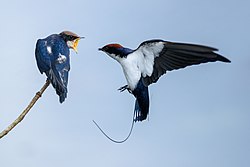Wire-tailed swallow: Difference between revisions
Citation bot (talk | contribs) Misc citation tidying. | Use this bot. Report bugs. | Suggested by AManWithNoPlan | Pages linked from cached User:AManWithNoPlan/sandbox3 | via #UCB_webform_linked 553/1238 |
No edit summary |
||
| Line 3: | Line 3: | ||
{{speciesbox |
{{speciesbox |
||
| name = Wire-tailed swallow |
| name = Wire-tailed swallow |
||
| image = |
| image = Wire-tailed_Swallow_Male_and_female.jpg |
||
| status = LC |
| status = LC |
||
| status_system = IUCN3.1 |
| status_system = IUCN3.1 |
||
Revision as of 04:24, 8 September 2021
This article includes a list of general references, but it lacks sufficient corresponding inline citations. (October 2010) |
| Wire-tailed swallow | |
|---|---|

| |
| Scientific classification | |
| Domain: | Eukaryota |
| Kingdom: | Animalia |
| Phylum: | Chordata |
| Class: | Aves |
| Order: | Passeriformes |
| Family: | Hirundinidae |
| Genus: | Hirundo |
| Species: | H. smithii
|
| Binomial name | |
| Hirundo smithii Leach, 1818
| |
The wire-tailed swallow (Hirundo smithii) is a small passerine bird in the swallow family. It has two subspecies: H. s. smithii, which occurs throughout Africa, and H. s. filifera, which is found in southern and southeastern Asia. It is mainly resident, but populations in Pakistan and northern India migrate further south in winter. The genus name Hirundo is the Latin word for swallow.[2] The species name smithii commemorates Christen Smith, a Norwegian botanist and geologist.[3]
Description
The wire-tailed swallow is a small swallow, measuring 18 cm (7.1 in) in length. It has bright blue upperparts, bright white underparts and a chestnut cap. Immature birds lack tail wires, and have dull brown (rather than chestnut) caps.[4] The species is named for the very long filamentous outermost tail feathers, which trail behind like two wires. The sexes are similar in appearance, but the female has shorter "wires". Juveniles have a brown crown, back and tail. The Asian form, H. s. filifera, is larger and longer-tailed than the abundant African H. s. smithii.
Habits
This bird is found in open country near water and human habitation. Wire-tailed swallows are fast flyers and they generally feed on insects, especially flies, while airborne. They are typically seen low over water, with which they are more closely associated than most swallows.
Nesting
The neat half-bowl nests are lined with mud collected in the swallows' beaks. They are placed on vertical surfaces near water under cliff ledges or nowadays more commonly on man-made structures such as buildings and bridges. The clutch is three to four eggs in Africa, up to five in Asia (Turner and Rose). These birds are solitary and territorial nesters, unlike many swallows, which tend to be colonial.
Taxonomy and systematics
The wire-tailed swallow is a member of the genus Hirundo, a cosmopolitan group of "barn swallows". It has two subspecies:[5]
- H. s. smithii was first described by William Elford Leach and K. D. Koenig in 1818.[6] Known as the African wire-tailed swallow, it is found throughout Africa.[5]
- H. s. filifera was first described by Stephens in 1826.[6] Also known as the Asian wire-tailed swallow, it is found in southern and southeastern Asia.[5]
Gallery
References
Citations
- ^ BirdLife International (2016). "Hirundo smithii". IUCN Red List of Threatened Species. 2016: e.T22712299A94328026. Retrieved 20 July 2020.
- ^ Jobling (2010), p. 193.
- ^ Jobling (2010), p. 358.
- ^ Stevenson, Terry; Fanshaw, John (December 2004). Birds of East Africa: Kenya, Tanzania, Uganda, Rwanda, Burundi. London, UK: A&C Black. p. 294. ISBN 978-0-7136-7347-0. Retrieved 28 August 2014.
- ^ a b c Monroe, Burt (1997). A World Checklist of Birds. New Haven, CT, USA: Yale University Press. p. 247. ISBN 978-0-300-07083-5. Retrieved 28 August 2014.
- ^ a b "ITIS Report: Hirundo smithii". Integrated Taxonomic Information System. Retrieved 28 August 2014.
Cited texts
- Jobling, James A. (2010). The Helm Dictionary of Scientific Names. London, UK: Christopher Helm. ISBN 978-1-4081-2501-4.
- Birds of India by Grimmett, Inskipp and Inskipp, ISBN 0-691-04910-6
- Birds of The Gambia by Barlow, Wacher and Disley, ISBN 1-873403-32-1
- Swallows and Martins by Turner and Rose, ISBN 0-7470-3202-5
External links
- Wire-tailed Swallow in The Atlas of Southern African Birds, second edition








